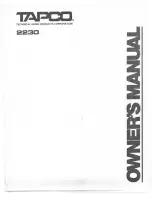
Chapter 6: Administering Virtual Clusters
166
Equalizer Installation and Administration Guide
In order to use an IPMI function to control a server, the server must have a Baseboard Management Controller
(BMC), a separate network interface that provides IPMI services. The BMC is usually enabled and configured via
the system BIOS, which must be accessed when the system boots. If the installed operating system on the server has
an IPMI driver installed and configured, you may also be able to configure the BMC from the command line or
using graphical utilities. The tools used to configure BMC controllers and IPMI drivers are specific to a server’s
hardware and OS platform. See the hardware and operating system documentation for your servers for specific BMC
and IPMI configuration instructions.
The BMC needs to be configured with the following information:
•
The
IP address
on which to listen for IPMI requests.
•
A
username
and
password
.
The
IP address
,
username
, and
password
specified when configuring the IPMI driver on the server must be
provided as arguments to the IPMI functions used in your Smart Event on Equalizer, so that Equalizer can log into
the IPMI subsystem on the server. The final argument to the IPMI functions is always “
lan
”. An example of a valid
IPMI function call is:
ipmi_poweron(“10.0.0.92”,”bmcroot”,”bmcpassword”,”lan”)
For an example of using IPMI functions in Smart Events, see the section “Using IPMI to Conserve Server
Resources” on page 172.
Complex Smart Event Expressions
The Smart Control language is flexible and allows you to combine functions, variables, and operators to create
complex expressions. For example, the order of processing in a Smart Event expression honors ‘short-circuiting’
rules; this includes ‘chained’ events which use the logical OR and AND operators to decide whether expressions on
the right side of the operator are evaluated.
Essentially, this means that the right hand side of an expression is not evaluated if the evaluation of the left side of
the expression determines the outcome. For example: if the left side of a two-operand expression that uses the
||
operator evaluates to ‘true’, the right side of the expression is not evaluated. Similarly, if the left side of a two-
operand expression that uses the
&&
operator evaluates to ‘false’, the right side of the expression is not evaluated.
Consider an event with the following
trigger
expression:
active_servers < 5 && server_wait(1000)
This trigger expression essentially overrides the default
smart timer
value (the time interval between event
evaluation) if there are less than 5 servers active in the cluster: if there are less than 5 active servers, a timer is set to
1000 seconds, and after this timer expires the
action
expression for the Smart Event is processed. Therefore, this
event will not be evaluated again for at least 1000 seconds. If there
are
5 or more active servers, the event will be
evaluated again after
smart timer
seconds.
Note that ‘short-circuiting’ in logical expressions is a standard feature of many programming languages. More
information on constructing logical expressions can be found in programming texts and on the Internet.
Managing Smart Events
Smart Events are a per-cluster resource, and so are listed under the cluster name in the left frame object tree, after
the servers in the cluster. Click on an existing Smart Event name to edit the event as discussed below. Click on any
cluster name in the left frame and then open the
Smart Events
tab in the right frame to manage all the Smart Events
Summary of Contents for E350GX
Page 18: ...Chapter Preface 18 Equalizer Installation and Administration Guide ...
Page 38: ...Chapter 1 Equalizer Overview 38 Equalizer Installation and Administration Guide ...
Page 80: ...Chapter 4 Equalizer Network Configuration 80 Equalizer Installation and Administration Guide ...
Page 110: ...Chapter 5 Configuring Equalizer Operation 110 Equalizer Installation and Administration Guide ...
Page 208: ...Chapter 7 Monitoring Equalizer Operation 208 Equalizer Installation and Administration Guide ...
Page 240: ...Chapter 8 Using Match Rules 238 Equalizer Installation and Administration Guide ...
Page 262: ...Appendix A Server Agent Probes 258 Equalizer Installation and Administration Guide ...
Page 274: ...Appendix B Timeout Configuration 270 Equalizer Installation and Administration Guide ...
Page 280: ...Appendix D Regular Expression Format 276 Equalizer Installation and Administration Guide ...
Page 310: ...Appendix F Equalizer VLB 306 Equalizer Installation and Administration Guide ...
Page 318: ...Appendix G Troubleshooting 314 Equalizer Installation and Administration Guide ...
















































